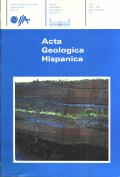Geología e hisrogeología de la zona endorreica de Bujaraloz-Sástago (Los Monegros, provincias de Zaragoza y Huesca)
Abstract
The closed-basin area of Bujaraloz-Sástago has a tabular relief and lies on upper-Oligocene and lower-Miocene detritic, gypsiferous and carbonatic deposits. The area contains a large number of small salt lakes which in most cases are related to groundwater discharge. Six distinct stratigraphic units can be distinguished in the sequence: 1) Basal Detrital Unit, 2) Lower Carbonatic Unit, 3) Middle Detrital Unit, 4) Middle Gypsiferous Unit, 5) Upper Detrital Unit, and 6) Upper Gypsiferous Unit.All these materials have a low permeability and contain high salinity groundwaters. In the area of study, two shallow aquifers can be distinguished. The Lower Aquifer is located on the limestone-gypsum sequence of the Middle Gypsiferous Unit. At the southem part of the study area, this aquifer is a water table aquifer in which groundwater discharge takes place mostly at the salt lakes. At the northem limit, it is confined by the Upper Detrital Unit which separates the Bottom Aquifer from an upper water table aquifer located on the Upper Gypsiferous Unit. In this Upper Aquifer groundwater flows from southwest to northeast and discharges at the lakes and creeks close to Bujaraloz.


